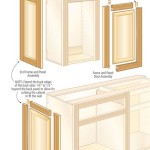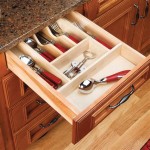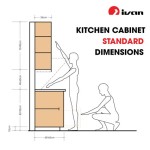Spice Storage Ideas For Small Kitchens
Efficient spice storage is a critical aspect of kitchen organization, particularly in compact spaces. A cluttered spice collection can quickly overwhelm countertops, cabinets, and drawers, making cooking less enjoyable and more time-consuming. Implementing thoughtful spice storage solutions not only maximizes space but also ensures easy access to essential flavors when preparing meals. This article explores various innovative and practical spice storage ideas tailored for small kitchens, offering strategies that prioritize accessibility, organization, and aesthetic appeal.
Optimizing Vertical Space: Wall-Mounted Spice Racks
When horizontal space is limited, leveraging vertical space becomes paramount. Wall-mounted spice racks offer an excellent solution for keeping spices within easy reach without sacrificing valuable counter or cabinet area. These racks come in a variety of materials, sizes, and styles, allowing for customization based on individual kitchen aesthetics and specific storage needs. Metal racks, for instance, provide a sleek and modern look, while wooden racks lend a more traditional and rustic feel.
Installation of wall-mounted spice racks is typically straightforward, often requiring only basic tools and hardware. Before installation, consider the proximity to the cooking area. Placing the rack near the stove or prep station ensures that spices are readily available while cooking. Furthermore, evaluate the weight capacity of the chosen rack to ensure it can safely hold the intended number of spice jars. If wall space is particularly limited, consider utilizing the backs of cabinet doors. Adhesive spice racks or narrow shelves can be affixed to the inside of cabinet doors, transforming otherwise unused space into a functional storage area.
Another excellent option is magnetic spice racks. These racks can be attached to the refrigerator’s side or any other metallic surface, providing convenient and space-saving storage. Magnetic spice jars are also available, allowing for a cohesive and organized look. When utilizing magnetic options, ensure the surface is clean and free of debris to ensure a secure attachment.
Utilizing tiered wall-mounted shelves is another effective approach to maximizing space. Tiered shelves allow for better visibility of all spices, preventing them from being hidden behind one another. Consider the depth of the shelves; shallower shelves prevent spices from getting lost or buried, while deeper shelves may require more careful organization to ensure everything is easily accessible. Regular maintenance and organization of wall-mounted spice racks are important to maintain efficiency and prevent clutter. Periodically check the expiration dates of spices and discard any that are past their prime. This proactive approach ensures that your spice collection remains fresh and organized, making cooking more enjoyable.
Drawer Inserts and Organizers: Streamlining Cabinet Space
Drawers often present a challenge for spice storage due to their horizontal orientation. However, with the right organizational tools, drawers can be transformed into efficient and visually appealing spice storage solutions. Drawer inserts and organizers are specifically designed to maximize drawer space while keeping spices in an orderly fashion.
Spice drawer inserts typically feature tiered or slotted compartments that allow bottles and jars to be stored on their sides, with the labels facing up for easy identification. These inserts come in a variety of materials, including wood, plastic, and metal, and can be trimmed to fit specific drawer dimensions. When selecting a drawer insert, consider the height of your spice jars. Ensure that the insert is deep enough to accommodate the jars without obstructing the drawer's closing mechanism.
Another effective drawer organization technique involves using adjustable dividers. These dividers can be customized to create individual compartments for spices, allowing for flexible organization based on the size and quantity of your collection. Adjustable dividers are particularly useful for storing spices in different-sized containers or for accommodating new additions to your spice collection. In addition to inserts and dividers, consider using non-slip liners to prevent spice jars from sliding around when the drawer is opened or closed. Non-slip liners provide added stability and prevent spills or breakage.
To optimize drawer space further, consider decanting spices into uniform containers. This not only creates a more visually appealing look but also allows for more efficient storage. Square or rectangular spice jars, for instance, maximize space better than round jars, particularly in confined drawer spaces. Labeling is crucial when using drawer organizers. Clearly label each spice jar to ensure quick and easy identification. Use waterproof labels or label makers to create professional-looking labels that are durable and easy to read. Regularly audit and reorganize your spice drawer to maintain order and prevent clutter. Discard expired spices and consolidate duplicates to free up valuable space. By implementing these drawer organization strategies, you can transform a chaotic drawer into a highly functional spice storage solution.
Creative Corner Solutions: Utilizing Awkward Spaces
Corners in kitchens can often be challenging spaces to utilize effectively. However, with creative spice storage solutions, corners can be transformed into functional and accessible storage areas. Corner shelves, lazy Susans, and custom-built units are all effective ways to maximize corner space and keep spices organized.
Corner shelves are a simple and cost-effective solution for utilizing corner space. These shelves can be installed directly into the corner, providing a convenient place to store spice jars. Tiered corner shelves are particularly useful, as they allow for better visibility of all spices. When installing corner shelves, consider the height and depth of the shelves to ensure they can accommodate your spice collection. Adjustable shelves are advantageous, as they provide flexibility to accommodate different-sized containers.
Lazy Susans are another excellent option for corner spice storage. These rotating shelves allow for easy access to all spices, even those located in the back of the corner. Lazy Susans come in a variety of sizes and materials and can be placed inside cabinets or on countertops. When selecting a lazy Susan, consider the weight capacity and the diameter to ensure it can hold your entire spice collection. Ensure the lazy Susan rotates smoothly and quietly for ease of use.
For a more customized corner spice storage solution, consider building a custom unit. This allows you to design a storage area that perfectly fits your specific needs and the dimensions of your corner. Custom-built units can incorporate features such as pull-out shelves, adjustable dividers, and integrated lighting to maximize functionality and accessibility. When designing a custom unit, consider incorporating elements that complement your kitchen's overall aesthetic. Use materials and finishes that match your existing cabinetry and countertops for a cohesive look.
Another creative corner solution involves repurposing existing items. For instance, a corner wine rack can be repurposed to store spice jars. The angled design of the wine rack provides easy visibility and access to the spices. Additionally, consider using corner caddies or baskets to store larger spice containers or frequently used spices. These caddies can be easily moved around the kitchen as needed. Regularly clean and organize corner spice storage areas to prevent clutter and maintain accessibility. Rotate spices periodically to ensure that older spices are used before they expire. By implementing these creative corner solutions, you can transform awkward spaces into functional and organized spice storage areas.
Repurposed Item Organization: Alternative Storage Solutions
Beyond conventional spice racks and organizers, various repurposed items can be creatively utilized to store spices in small kitchens. By thinking outside the box, everyday objects can be transformed into efficient and aesthetically pleasing spice storage solutions. Repurposing items is not only cost-effective but also adds a unique and personal touch to your kitchen.
One common repurposed item is a mason jar. Mason jars are readily available and come in various sizes, making them ideal for storing spices. Affix labels to the jars for easy identification. Mason jars can be stored on shelves, in drawers, or even hung from a wall-mounted rack using wire or twine. Another readily available item that can be repurposed for spice storage is a test tube rack. Test tube racks provide individual compartments for spice jars, keeping them organized and preventing them from toppling over. These racks can be placed on countertops or inside cabinets.
Small metal tins, such as Altoids tins, can be used to store smaller quantities of spices. These tins are particularly useful for storing single-serving portions or for creating spice blends. Label the tins clearly and store them in a drawer or on a shelf. Other items, such as baby food jars, small condiment containers, and even repurposed candle jars, can be used to store spices. The key is to ensure that the containers are clean, dry, and airtight to maintain the freshness and quality of the spices. Old tea tins can be repurposed into stylish spice containers. The decorative designs on tea tins can add a touch of charm to your kitchen. Label the tins clearly and store them on a shelf or in a drawer.
Another creative repurposing option involves using a shoe organizer. Shoe organizers with clear pockets can be hung on the back of a door or on a wall, providing individual compartments for spice jars. This is a particularly useful solution for storing a large collection of spices in a small space. Regularly inspect repurposed items to ensure they are in good condition and free from damage. Clean and disinfect items before repurposing them to ensure they are safe for food storage. By embracing creativity and repurposing everyday items, you can create unique and cost-effective spice storage solutions for your small kitchen.
Maintaining Freshness: Proper Spice Storage Techniques
Regardless of the storage method employed, proper spice storage techniques are crucial for maintaining freshness and flavor. Spices can lose their potency over time if exposed to heat, light, moisture, and air. Implementing the following strategies will help ensure that your spices remain fresh and flavorful for longer.
First, store spices in airtight containers. This prevents moisture and air from entering, which can degrade the quality of the spices. Glass jars with tight-fitting lids, metal tins, or plastic containers with rubber seals are all suitable options. Avoid storing spices in plastic bags, as these are not airtight and can allow moisture and air to penetrate. Second, store spices in a cool, dark place. Heat and light can accelerate the loss of flavor and aroma. Avoid storing spices near the stove, oven, or in direct sunlight. A pantry, cabinet, or drawer away from heat sources is an ideal location.
Third, purchase whole spices whenever possible. Whole spices retain their flavor and aroma longer than ground spices. Grind whole spices as needed using a spice grinder or mortar and pestle. This ensures that you are using the freshest possible spices. Fourth, avoid storing spices in the refrigerator or freezer. The temperature fluctuations and moisture in these environments can damage the spices. Instead, store spices at room temperature in a dry location.
Fifth, label all spice containers with the date of purchase. This allows you to track the age of your spices and discard any that are past their prime. Most ground spices have a shelf life of about one to two years, while whole spices can last up to three to four years. Sixth, avoid sprinkling spices directly from the container into a steaming pot. The moisture from the steam can enter the container and cause the spices to clump and lose their flavor. Instead, spoon the desired amount of spice into your hand or a separate bowl before adding it to the cooking vessel.
Seventh, regularly check the expiration dates of your spices and discard any that are past their prime. Expired spices will have a dull color, weak aroma, and diminished flavor. Eighth, consider storing frequently used spices in smaller containers and refilling them as needed from larger bulk containers. This minimizes the exposure of the bulk spices to air and moisture. By implementing these proper spice storage techniques, you can ensure that your spices remain fresh, flavorful, and ready to enhance your culinary creations.

Diy Spice Rack Create Your Own Space Saving Solution

9 Smart Spice Storage Ideas For A Small Kitchen Organizenvy

31 Amazing Space Saving Kitchen S
:max_bytes(150000):strip_icc()/nycneat-7b665e4f521d4be49b65e428a3373478.png?strip=all)
50 Small Kitchen Storage Ideas You Ll Wish Knew Sooner

Kitchen Organization How I Organized My Spice Cabinet A Cultivated Nest

20 Brilliant Spice Rack Ideas For Your Small Kitchen

How To Organize Spices In A Small Kitchen

Baking Cabinet Organization Spice Storage Ideas On Sutton Place

Wooden Spice Rack Yellow Patina Vintage Kitchen Storage With 15 Jars Drawers And Wall Mount Bulles D épices

Creative Spice Storage Ideas A Blissful Nest
Related Posts








